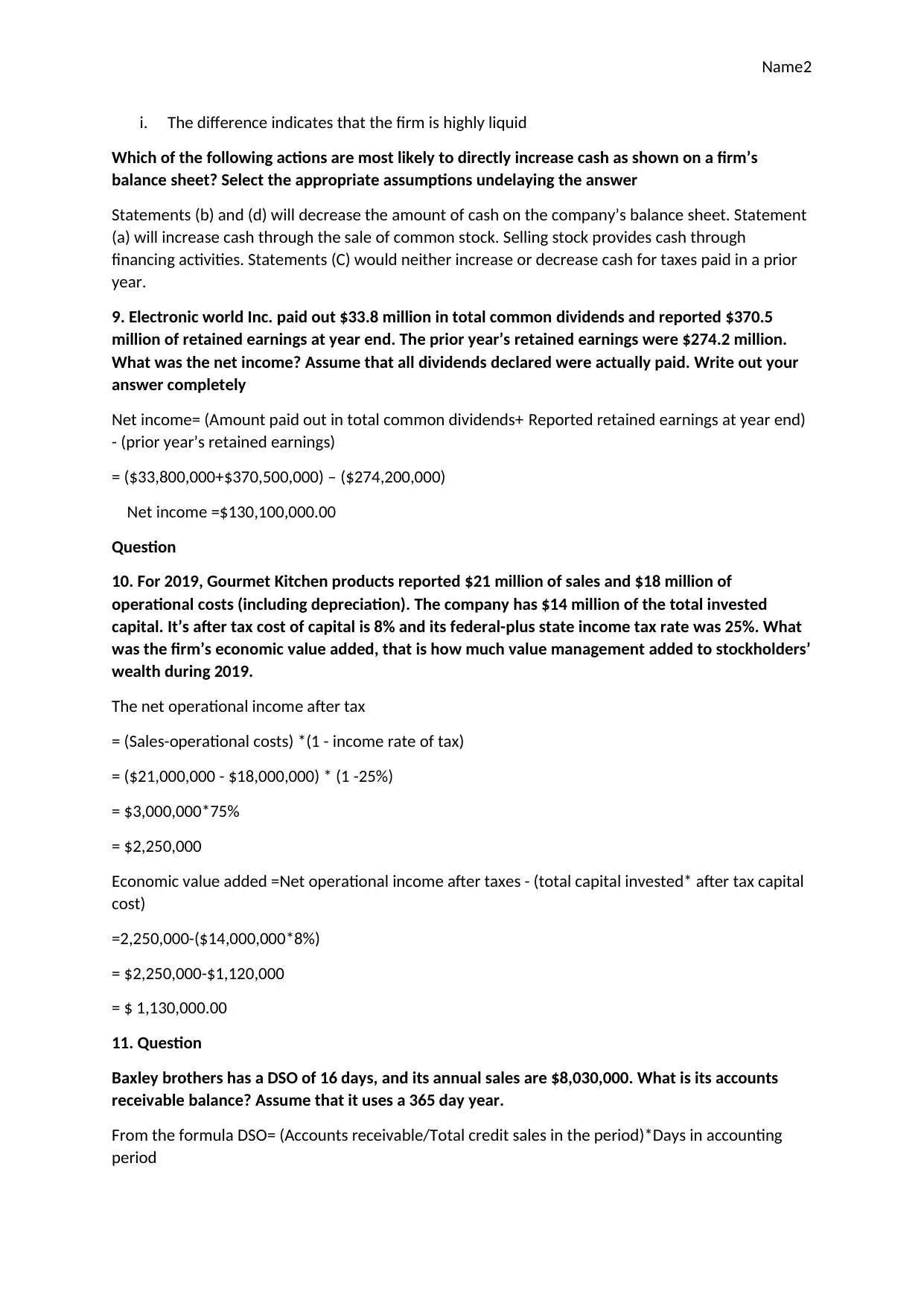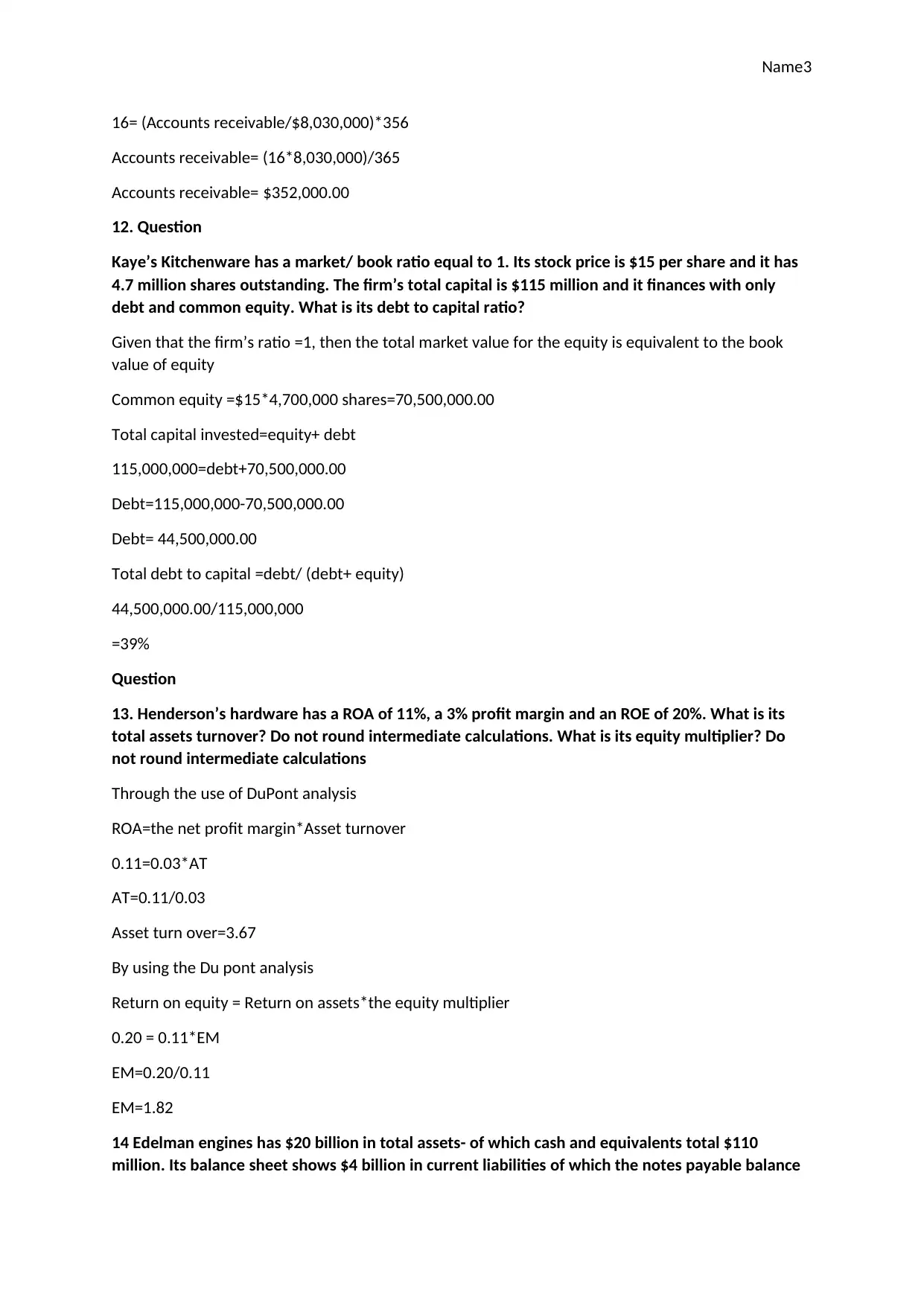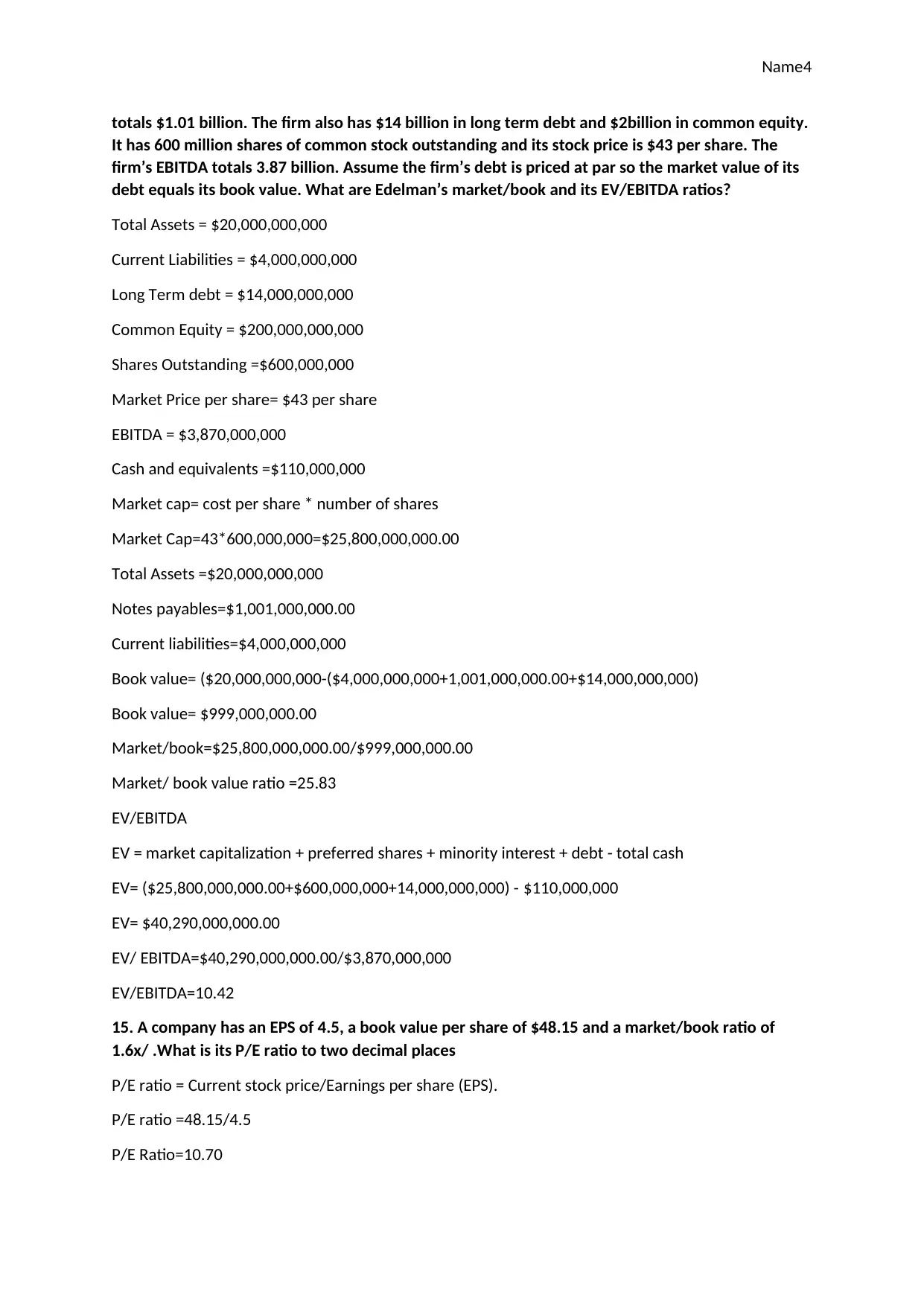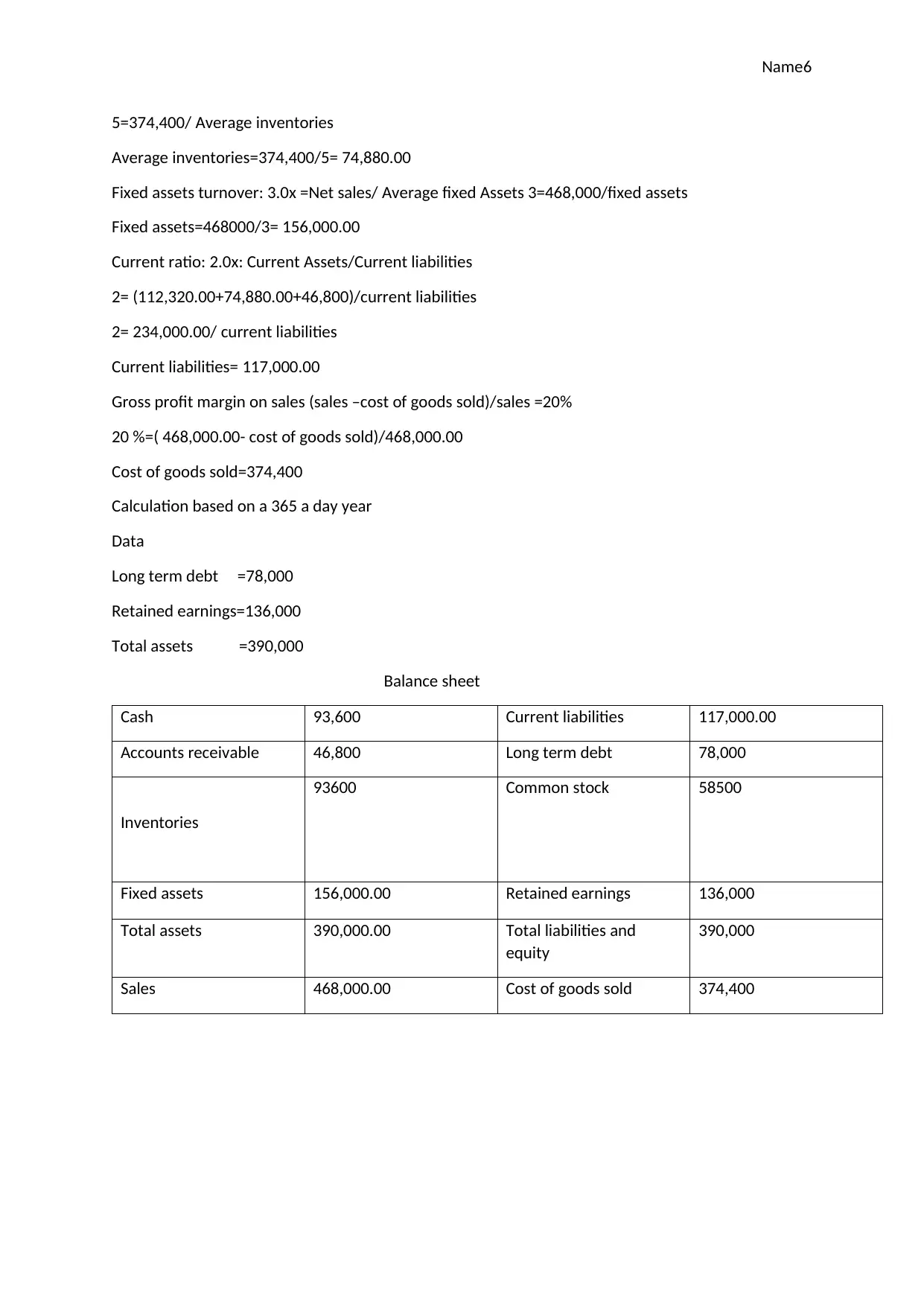Financial Management Homework: Calculations and Analysis
VerifiedAdded on 2022/11/03
|7
|1477
|263
Homework Assignment
AI Summary
This document presents a comprehensive solution to a financial management homework assignment. The solution covers a range of financial concepts, including the calculation of total debt, net working capital, and net income. It delves into ratio analysis, such as Days Sales Outstanding (DSO), market/book ratio, and debt-to-capital ratio. The assignment also explores economic value added (EVA), return on assets (ROA), and return on equity (ROE) calculations using DuPont analysis. Furthermore, it provides solutions for market/book and EV/EBITDA ratios, price-to-earnings (P/E) ratio, and return on invested capital (ROIC). Finally, the solution includes a complete balance sheet and sales information based on provided financial ratios and data, demonstrating a thorough understanding of financial statement analysis and performance evaluation.

Name1
Name
Professor
Affiliation
Date
Financial management
Question 1
a. Company’s total debt
Notes payables=$160,000
Long term debt=$754,000
Company’s total debt=$160,000+$754,000
Total debt=$914,000
b. total liabilities and equity
$2,900,000
c. Balance of the current assets
Current Assets=$2,900,000-$2,400,000
Current Assets=$500,000
d. Current liabilities
2,900,000-2,204,000
=$696,000
e. Accounts payable and Accruals
=$696,000-$160,000
$536,000
f. Net working capital
Net working capital=current assets- current liabilities
$500,000-696,000
=-$196,000
g. Firm’s Net operational working capital
Net operational working capital $500,000-696000-160000
Net operational working capital=-$36000
h. Monetary difference
The current assets are equal to operational current assets
Name
Professor
Affiliation
Date
Financial management
Question 1
a. Company’s total debt
Notes payables=$160,000
Long term debt=$754,000
Company’s total debt=$160,000+$754,000
Total debt=$914,000
b. total liabilities and equity
$2,900,000
c. Balance of the current assets
Current Assets=$2,900,000-$2,400,000
Current Assets=$500,000
d. Current liabilities
2,900,000-2,204,000
=$696,000
e. Accounts payable and Accruals
=$696,000-$160,000
$536,000
f. Net working capital
Net working capital=current assets- current liabilities
$500,000-696,000
=-$196,000
g. Firm’s Net operational working capital
Net operational working capital $500,000-696000-160000
Net operational working capital=-$36000
h. Monetary difference
The current assets are equal to operational current assets
Paraphrase This Document
Need a fresh take? Get an instant paraphrase of this document with our AI Paraphraser

Name2
i. The difference indicates that the firm is highly liquid
Which of the following actions are most likely to directly increase cash as shown on a firm’s
balance sheet? Select the appropriate assumptions undelaying the answer
Statements (b) and (d) will decrease the amount of cash on the company’s balance sheet. Statement
(a) will increase cash through the sale of common stock. Selling stock provides cash through
financing activities. Statements (C) would neither increase or decrease cash for taxes paid in a prior
year.
9. Electronic world Inc. paid out $33.8 million in total common dividends and reported $370.5
million of retained earnings at year end. The prior year’s retained earnings were $274.2 million.
What was the net income? Assume that all dividends declared were actually paid. Write out your
answer completely
Net income= (Amount paid out in total common dividends+ Reported retained earnings at year end)
- (prior year’s retained earnings)
= ($33,800,000+$370,500,000) – ($274,200,000)
Net income =$130,100,000.00
Question
10. For 2019, Gourmet Kitchen products reported $21 million of sales and $18 million of
operational costs (including depreciation). The company has $14 million of the total invested
capital. It’s after tax cost of capital is 8% and its federal-plus state income tax rate was 25%. What
was the firm’s economic value added, that is how much value management added to stockholders’
wealth during 2019.
The net operational income after tax
= (Sales-operational costs) *(1 - income rate of tax)
= ($21,000,000 - $18,000,000) * (1 -25%)
= $3,000,000*75%
= $2,250,000
Economic value added =Net operational income after taxes - (total capital invested* after tax capital
cost)
=2,250,000-($14,000,000*8%)
= $2,250,000-$1,120,000
= $ 1,130,000.00
11. Question
Baxley brothers has a DSO of 16 days, and its annual sales are $8,030,000. What is its accounts
receivable balance? Assume that it uses a 365 day year.
From the formula DSO= (Accounts receivable/Total credit sales in the period)*Days in accounting
period
i. The difference indicates that the firm is highly liquid
Which of the following actions are most likely to directly increase cash as shown on a firm’s
balance sheet? Select the appropriate assumptions undelaying the answer
Statements (b) and (d) will decrease the amount of cash on the company’s balance sheet. Statement
(a) will increase cash through the sale of common stock. Selling stock provides cash through
financing activities. Statements (C) would neither increase or decrease cash for taxes paid in a prior
year.
9. Electronic world Inc. paid out $33.8 million in total common dividends and reported $370.5
million of retained earnings at year end. The prior year’s retained earnings were $274.2 million.
What was the net income? Assume that all dividends declared were actually paid. Write out your
answer completely
Net income= (Amount paid out in total common dividends+ Reported retained earnings at year end)
- (prior year’s retained earnings)
= ($33,800,000+$370,500,000) – ($274,200,000)
Net income =$130,100,000.00
Question
10. For 2019, Gourmet Kitchen products reported $21 million of sales and $18 million of
operational costs (including depreciation). The company has $14 million of the total invested
capital. It’s after tax cost of capital is 8% and its federal-plus state income tax rate was 25%. What
was the firm’s economic value added, that is how much value management added to stockholders’
wealth during 2019.
The net operational income after tax
= (Sales-operational costs) *(1 - income rate of tax)
= ($21,000,000 - $18,000,000) * (1 -25%)
= $3,000,000*75%
= $2,250,000
Economic value added =Net operational income after taxes - (total capital invested* after tax capital
cost)
=2,250,000-($14,000,000*8%)
= $2,250,000-$1,120,000
= $ 1,130,000.00
11. Question
Baxley brothers has a DSO of 16 days, and its annual sales are $8,030,000. What is its accounts
receivable balance? Assume that it uses a 365 day year.
From the formula DSO= (Accounts receivable/Total credit sales in the period)*Days in accounting
period

Name3
16= (Accounts receivable/$8,030,000)*356
Accounts receivable= (16*8,030,000)/365
Accounts receivable= $352,000.00
12. Question
Kaye’s Kitchenware has a market/ book ratio equal to 1. Its stock price is $15 per share and it has
4.7 million shares outstanding. The firm’s total capital is $115 million and it finances with only
debt and common equity. What is its debt to capital ratio?
Given that the firm’s ratio =1, then the total market value for the equity is equivalent to the book
value of equity
Common equity =$15*4,700,000 shares=70,500,000.00
Total capital invested=equity+ debt
115,000,000=debt+70,500,000.00
Debt=115,000,000-70,500,000.00
Debt= 44,500,000.00
Total debt to capital =debt/ (debt+ equity)
44,500,000.00/115,000,000
=39%
Question
13. Henderson’s hardware has a ROA of 11%, a 3% profit margin and an ROE of 20%. What is its
total assets turnover? Do not round intermediate calculations. What is its equity multiplier? Do
not round intermediate calculations
Through the use of DuPont analysis
ROA=the net profit margin*Asset turnover
0.11=0.03*AT
AT=0.11/0.03
Asset turn over=3.67
By using the Du pont analysis
Return on equity = Return on assets*the equity multiplier
0.20 = 0.11*EM
EM=0.20/0.11
EM=1.82
14 Edelman engines has $20 billion in total assets- of which cash and equivalents total $110
million. Its balance sheet shows $4 billion in current liabilities of which the notes payable balance
16= (Accounts receivable/$8,030,000)*356
Accounts receivable= (16*8,030,000)/365
Accounts receivable= $352,000.00
12. Question
Kaye’s Kitchenware has a market/ book ratio equal to 1. Its stock price is $15 per share and it has
4.7 million shares outstanding. The firm’s total capital is $115 million and it finances with only
debt and common equity. What is its debt to capital ratio?
Given that the firm’s ratio =1, then the total market value for the equity is equivalent to the book
value of equity
Common equity =$15*4,700,000 shares=70,500,000.00
Total capital invested=equity+ debt
115,000,000=debt+70,500,000.00
Debt=115,000,000-70,500,000.00
Debt= 44,500,000.00
Total debt to capital =debt/ (debt+ equity)
44,500,000.00/115,000,000
=39%
Question
13. Henderson’s hardware has a ROA of 11%, a 3% profit margin and an ROE of 20%. What is its
total assets turnover? Do not round intermediate calculations. What is its equity multiplier? Do
not round intermediate calculations
Through the use of DuPont analysis
ROA=the net profit margin*Asset turnover
0.11=0.03*AT
AT=0.11/0.03
Asset turn over=3.67
By using the Du pont analysis
Return on equity = Return on assets*the equity multiplier
0.20 = 0.11*EM
EM=0.20/0.11
EM=1.82
14 Edelman engines has $20 billion in total assets- of which cash and equivalents total $110
million. Its balance sheet shows $4 billion in current liabilities of which the notes payable balance
⊘ This is a preview!⊘
Do you want full access?
Subscribe today to unlock all pages.

Trusted by 1+ million students worldwide

Name4
totals $1.01 billion. The firm also has $14 billion in long term debt and $2billion in common equity.
It has 600 million shares of common stock outstanding and its stock price is $43 per share. The
firm’s EBITDA totals 3.87 billion. Assume the firm’s debt is priced at par so the market value of its
debt equals its book value. What are Edelman’s market/book and its EV/EBITDA ratios?
Total Assets = $20,000,000,000
Current Liabilities = $4,000,000,000
Long Term debt = $14,000,000,000
Common Equity = $200,000,000,000
Shares Outstanding =$600,000,000
Market Price per share= $43 per share
EBITDA = $3,870,000,000
Cash and equivalents =$110,000,000
Market cap= cost per share * number of shares
Market Cap=43*600,000,000=$25,800,000,000.00
Total Assets =$20,000,000,000
Notes payables=$1,001,000,000.00
Current liabilities=$4,000,000,000
Book value= ($20,000,000,000-($4,000,000,000+1,001,000,000.00+$14,000,000,000)
Book value= $999,000,000.00
Market/book=$25,800,000,000.00/$999,000,000.00
Market/ book value ratio =25.83
EV/EBITDA
EV = market capitalization + preferred shares + minority interest + debt - total cash
EV= ($25,800,000,000.00+$600,000,000+14,000,000,000) - $110,000,000
EV= $40,290,000,000.00
EV/ EBITDA=$40,290,000,000.00/$3,870,000,000
EV/EBITDA=10.42
15. A company has an EPS of 4.5, a book value per share of $48.15 and a market/book ratio of
1.6x/ .What is its P/E ratio to two decimal places
P/E ratio = Current stock price/Earnings per share (EPS).
P/E ratio =48.15/4.5
P/E Ratio=10.70
totals $1.01 billion. The firm also has $14 billion in long term debt and $2billion in common equity.
It has 600 million shares of common stock outstanding and its stock price is $43 per share. The
firm’s EBITDA totals 3.87 billion. Assume the firm’s debt is priced at par so the market value of its
debt equals its book value. What are Edelman’s market/book and its EV/EBITDA ratios?
Total Assets = $20,000,000,000
Current Liabilities = $4,000,000,000
Long Term debt = $14,000,000,000
Common Equity = $200,000,000,000
Shares Outstanding =$600,000,000
Market Price per share= $43 per share
EBITDA = $3,870,000,000
Cash and equivalents =$110,000,000
Market cap= cost per share * number of shares
Market Cap=43*600,000,000=$25,800,000,000.00
Total Assets =$20,000,000,000
Notes payables=$1,001,000,000.00
Current liabilities=$4,000,000,000
Book value= ($20,000,000,000-($4,000,000,000+1,001,000,000.00+$14,000,000,000)
Book value= $999,000,000.00
Market/book=$25,800,000,000.00/$999,000,000.00
Market/ book value ratio =25.83
EV/EBITDA
EV = market capitalization + preferred shares + minority interest + debt - total cash
EV= ($25,800,000,000.00+$600,000,000+14,000,000,000) - $110,000,000
EV= $40,290,000,000.00
EV/ EBITDA=$40,290,000,000.00/$3,870,000,000
EV/EBITDA=10.42
15. A company has an EPS of 4.5, a book value per share of $48.15 and a market/book ratio of
1.6x/ .What is its P/E ratio to two decimal places
P/E ratio = Current stock price/Earnings per share (EPS).
P/E ratio =48.15/4.5
P/E Ratio=10.70
Paraphrase This Document
Need a fresh take? Get an instant paraphrase of this document with our AI Paraphraser

Name5
16. A firm has a profit margin of 3.5% and an equity multiplier of 1.8. Its sales are $370 million and
it has total assets of 185 million. What is its ROE?
ROE=Net profit margin* Asset turn over* equity multipliers
ROE= (3.5%*1.8)*(370,000,000/185,000,000)
ROE =13.00%
17. Baker industries net income is $27,000. Its interest expense is $5000 and its tax rate is 25%. Its
notes payable equals $26,000, long term debt equals $80,000 and a common equity equals
$260,000. The firm finances with only debt and common equity, so it has no preferred stock. What
are the firm’s ROE and ROIC
Given: Net income =27,000
ROE=net income/Common equity
ROE=27,000/260,000
ROE=10%
For, ROIC, we determine EBIT and capital invested
EBIT = Net Income + Interest + Taxes
EBIT=$27,000+$5000+35%( 31000)
= $42850
Capital invested
Notes payable equals $26,000
Long term debt equals $80,000
Common equity=$260,000
Total invested =26,000+80000+260000
Total =$366,000.00
ROIC=EBIT (1-T)/Total invested capital
ROIC= (42,850.00 (1-25%))/ (360,000.00)
ROIC= 9.00%
18. Complete the balance sheet and sales information using the following data
Total assets turnover: 1.2x: Net sales/Average Total sales=1.2*390,000
Day’s sales outstanding: 36.5 days (Accounts receivable/Total credit sales)* 365
Accounts receivable= (36.5*468000)/365=$46800
Inventory turnover ratio 5X =cost of goods sold/Average inventories
16. A firm has a profit margin of 3.5% and an equity multiplier of 1.8. Its sales are $370 million and
it has total assets of 185 million. What is its ROE?
ROE=Net profit margin* Asset turn over* equity multipliers
ROE= (3.5%*1.8)*(370,000,000/185,000,000)
ROE =13.00%
17. Baker industries net income is $27,000. Its interest expense is $5000 and its tax rate is 25%. Its
notes payable equals $26,000, long term debt equals $80,000 and a common equity equals
$260,000. The firm finances with only debt and common equity, so it has no preferred stock. What
are the firm’s ROE and ROIC
Given: Net income =27,000
ROE=net income/Common equity
ROE=27,000/260,000
ROE=10%
For, ROIC, we determine EBIT and capital invested
EBIT = Net Income + Interest + Taxes
EBIT=$27,000+$5000+35%( 31000)
= $42850
Capital invested
Notes payable equals $26,000
Long term debt equals $80,000
Common equity=$260,000
Total invested =26,000+80000+260000
Total =$366,000.00
ROIC=EBIT (1-T)/Total invested capital
ROIC= (42,850.00 (1-25%))/ (360,000.00)
ROIC= 9.00%
18. Complete the balance sheet and sales information using the following data
Total assets turnover: 1.2x: Net sales/Average Total sales=1.2*390,000
Day’s sales outstanding: 36.5 days (Accounts receivable/Total credit sales)* 365
Accounts receivable= (36.5*468000)/365=$46800
Inventory turnover ratio 5X =cost of goods sold/Average inventories

Name6
5=374,400/ Average inventories
Average inventories=374,400/5= 74,880.00
Fixed assets turnover: 3.0x =Net sales/ Average fixed Assets 3=468,000/fixed assets
Fixed assets=468000/3= 156,000.00
Current ratio: 2.0x: Current Assets/Current liabilities
2= (112,320.00+74,880.00+46,800)/current liabilities
2= 234,000.00/ current liabilities
Current liabilities= 117,000.00
Gross profit margin on sales (sales –cost of goods sold)/sales =20%
20 %=( 468,000.00- cost of goods sold)/468,000.00
Cost of goods sold=374,400
Calculation based on a 365 a day year
Data
Long term debt =78,000
Retained earnings=136,000
Total assets =390,000
Balance sheet
Cash 93,600 Current liabilities 117,000.00
Accounts receivable 46,800 Long term debt 78,000
Inventories
93600 Common stock 58500
Fixed assets 156,000.00 Retained earnings 136,000
Total assets 390,000.00 Total liabilities and
equity
390,000
Sales 468,000.00 Cost of goods sold 374,400
5=374,400/ Average inventories
Average inventories=374,400/5= 74,880.00
Fixed assets turnover: 3.0x =Net sales/ Average fixed Assets 3=468,000/fixed assets
Fixed assets=468000/3= 156,000.00
Current ratio: 2.0x: Current Assets/Current liabilities
2= (112,320.00+74,880.00+46,800)/current liabilities
2= 234,000.00/ current liabilities
Current liabilities= 117,000.00
Gross profit margin on sales (sales –cost of goods sold)/sales =20%
20 %=( 468,000.00- cost of goods sold)/468,000.00
Cost of goods sold=374,400
Calculation based on a 365 a day year
Data
Long term debt =78,000
Retained earnings=136,000
Total assets =390,000
Balance sheet
Cash 93,600 Current liabilities 117,000.00
Accounts receivable 46,800 Long term debt 78,000
Inventories
93600 Common stock 58500
Fixed assets 156,000.00 Retained earnings 136,000
Total assets 390,000.00 Total liabilities and
equity
390,000
Sales 468,000.00 Cost of goods sold 374,400
⊘ This is a preview!⊘
Do you want full access?
Subscribe today to unlock all pages.

Trusted by 1+ million students worldwide

Name7
1 out of 7
Related Documents
Your All-in-One AI-Powered Toolkit for Academic Success.
+13062052269
info@desklib.com
Available 24*7 on WhatsApp / Email
![[object Object]](/_next/static/media/star-bottom.7253800d.svg)
Unlock your academic potential
Copyright © 2020–2025 A2Z Services. All Rights Reserved. Developed and managed by ZUCOL.





